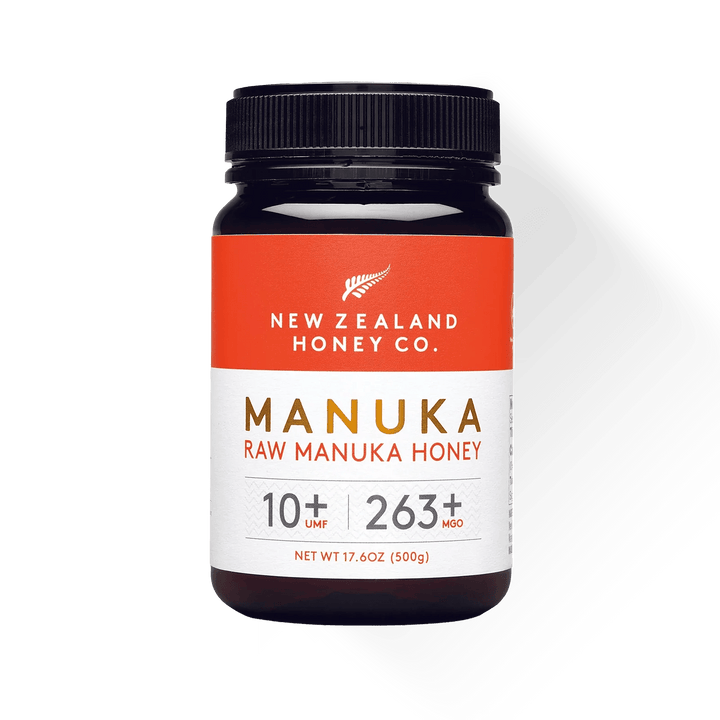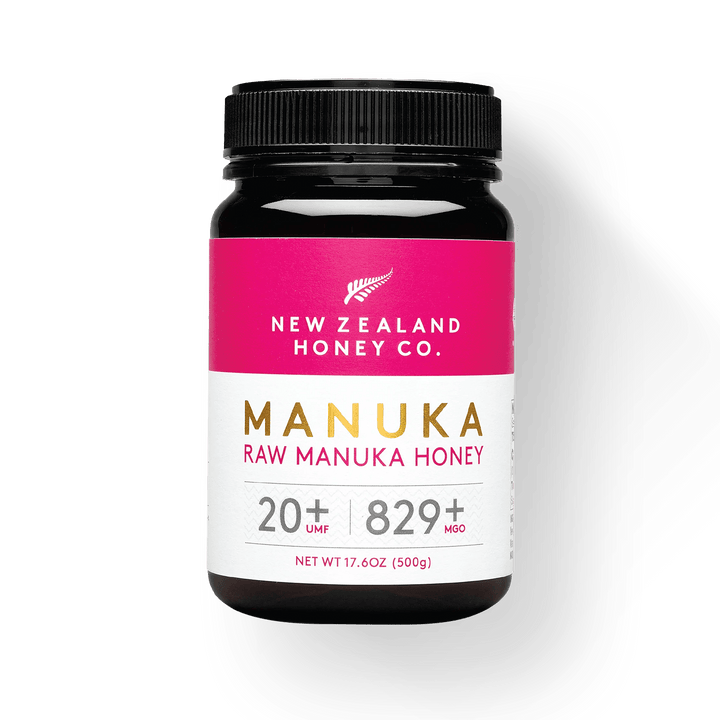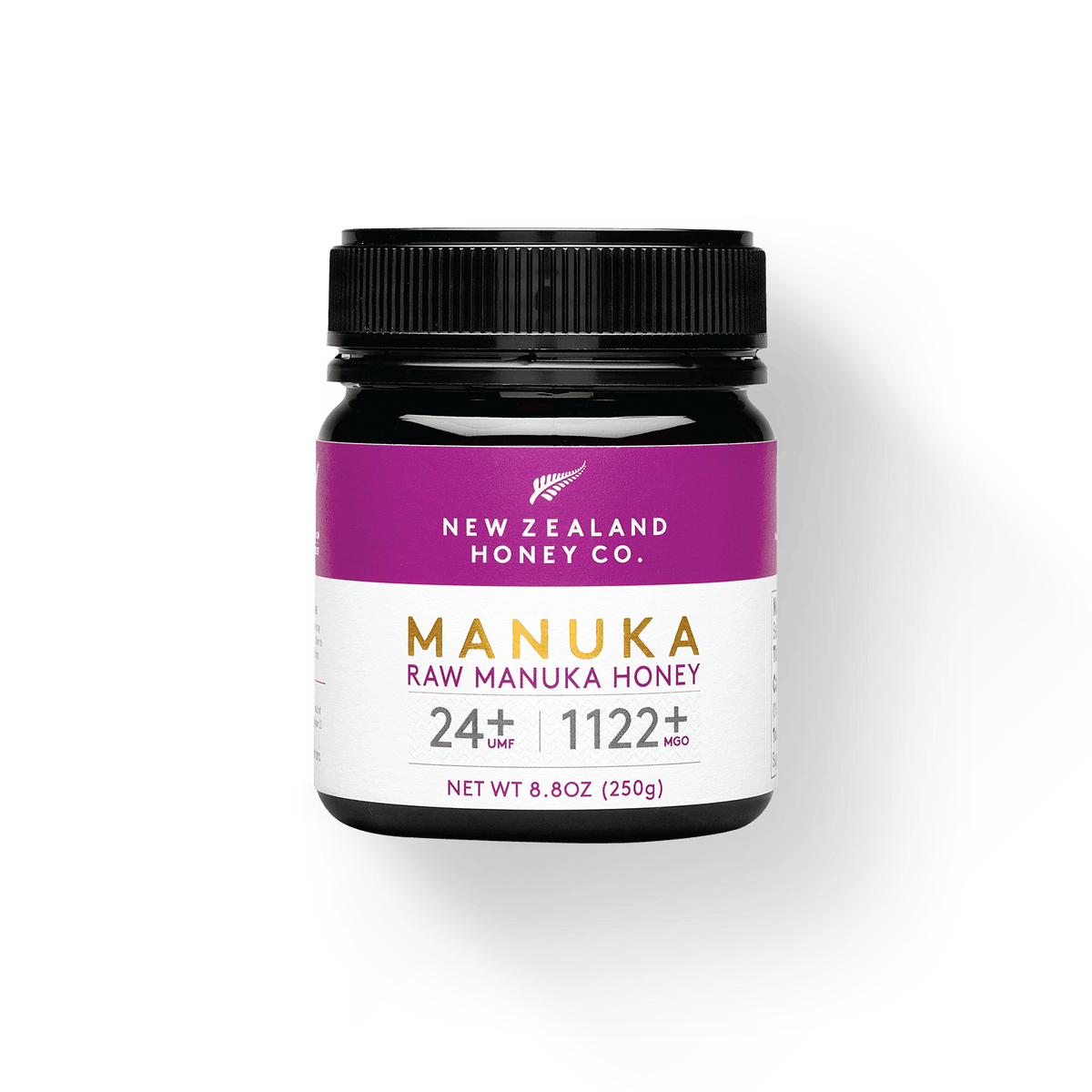EDUCATION
What is Monofloral Manuka Honey and Why Does it Matter?
10 minute read
Essential Takeaways
Multifloral manuka honey consists of nectar collected from multiple flowers, whereas monofloral manuka honey is made from predominantly manuka nectar.
Monofloral manuka honey is more potent than multifloral manuka honey.
Therefore, monofloral manuka honey tends to have more health benefits, and attracts a higher price.
It’s important to understand the differences between monofloral manuka honey and multifloral manuka honey so you can make educated decisions when buying.
Out of all the jargon surrounding manuka honey, this is potentially the most important distinction to understand.
Why? Because you want to get what you pay for!
All the benefits you’ve heard about when it comes to manuka honey are far more prevalent in monofloral manuka honey.
How can one little prefix make so much difference?
Well, in this guide we dive into exactly that. By the end, you’ll have an understanding of why monofloral honey is the best type of manuka honey, and you’ll know exactly what to look for when buying it.
In this guide to monofloral manuka honey, you’ll learn about:
- What is monofloral manuka honey?
-
Monofloral manuka honey vs multifloral manuka honey
- How they’re different
-
Monofloral manuka honey benefits
- Great for skin and hair
- Heal your wounds and scars
-
Should I get monofloral or multifloral manuka honey?
- Which manuka honey is best?
- When you buy multifloral manuka honey, you’re missing out on this
-
How do I know it’s truly monofloral?
- Markers of monofloral manuka honey
- Does MGO mean it’s monofloral?
- Why is monofloral manuka honey expensive?
- The best place to buy monofloral manuka honey
What Is Monofloral Manuka Honey?
Mono means “one, only, single”. Flora means “of flowers”.
So, monofloral means “of only one flower”.
Of course, in a wild environment it’s almost impossible to ensure that bees collect nectar from only one type of flower, so in practicality, monofloral means “predominantly from one type of flower”.
So, what does monofloral mean in manuka honey?
That one flower is the manuka flower, belonging to the manuka tree, also known as Leptospermum Scoparium. The name ‘mānuka’ has Māori origins, as the New Zealand plant has long been used for therapeutic purposes.
New Zealand is abundant in the two things needed to create manuka honey:
- Remote areas with lots of space
- Large coverage of manuka bushes
The perfect meeting of these two means that beekeepers can place their hives in such areas where bees primarily have access to manuka flowers.
Even though bees can fly up to 5 kilometers to collect nectar, this nectar will still be predominantly from manuka flowers.
This means that - after testing of course - this honey can be confidently sold as monofloral manuka honey.
Monofloral Manuka Honey versus Multifloral Manuka Honey
So if monofloral means “of only one flower”, multifloral means… “of multiple flowers”.
Multifloral manuka honey is still manuka honey, but the nectar has not only been collected from manuka flowers. The bees have visited other flowers as well, as perhaps the manuka bushes surrounding the hives don’t extend to the borders of their flight potential.
Sometimes, multifloral manuka honey, or “blended” manuka honey has been mixed after harvesting. It might contain some certified monofloral manuka honey that has been mixed with other bush honeys to make it less potent and bring the price down to a more palatable number.
Both multifloral and monofloral manuka honey must pass rigorous tests set out by New Zealand’s Ministry for Primary Industries.
“A combination of five attributes (4 chemicals, 1 DNA marker from mānuka pollen) are required to authenticate monofloral and multifloral mānuka honey.”
Here’s a visual representation of the scientific make-up of both types of manuka honey:
Source: Ministry for Primary Industries
So, in non-science terms, what is the difference between multifloral and monofloral manuka honey?
These honeys differ from each other in a few ways:
- Potency. Monofloral manuka honey is more potent than multifloral honey.
- Source. Monofloral manuka honey tends to come from more remote areas where there’s a large enough region of manuka bushes to ensure the bees collect predominantly from those. Multifloral manuka honey either comes from an area of mixed flora, or it’s blended afterwards.
- Taste. Monofloral manuka honey tends to taste ‘stronger’. It’s been described as earthy, sometimes bitter, and not as sweet as ‘regular’ honey.
- Health benefits. These are typically associated with monofloral honey because of its potency (we’ll go into more detail soon). However, it’s completely possible that multifloral manuka honey can still offer more health benefits than other non-manuka honeys.
- Purchasing source and price. You can generally find multifloral manuka honey in shops like supermarkets, at a relatively low price. Monofloral manuka honey is of higher value (and harder to source), so is more expensive when sold in supermarkets and can also be found in health shops, pharmacies, from trusted online sources, or directly from the beekeeper or wholesaler.
Monofloral Manuka Honey Benefits - What Are They?
Now that we’ve established how monofloral differs from multifloral, let’s dive into the health benefits of monofloral manuka honey.
We’ve written a whole guide on the benefits of manuka honey, but here’s a quick summary of how it can be helpful to you, and the things you can do with it.
Glow from the inside out
- Boost your immunity with a regular intake of antibacterial and antimicrobial activity.
- Balance your digestive system and reduce acid reflux.
- Look after your teeth and gums - manuka honey is great for oral health!
Great for your skin and hair
- Fight acne, reduce redness on your face, and cleanse your pores.
- Keep your facial skin hydrated and age gracefully with manuka honey face masks.
- Give your luscious locks moisture and hydration with a manuka honey hair mask.
Heal your wounds and scars
- Apply it generously to open wounds and cuts to help you recover.
- Rub it into potential scars and existing scars to prevent long-term markings.
Since it’s often the antibacterial and antimicrobial qualities of the honey that can give us these health benefits, they tend to be associated with monofloral manuka honey.
Raw monofloral manuka honey is even better, because it hasn’t been filtered excessively so lots of the pollen (and raw goodness) stays in the honey.
Multifloral manuka honey is simply not as strong. While it might feel relaxing to rub it on your face, UMF™ graded honey will help you achieve better results.
We’ll cover more on this soon as we dive into the differences between monofloral and multifloral manuka honey.
Read more: Manuka Honey Health Benefits
Should I Buy Monofloral or Multifloral Manuka Honey?
In almost every way, monofloral manuka honey is superior.
If the reason you’re interested in manuka honey is the concentrated antibacterial and antimicrobial properties, monofloral is the only way to go.
Multifloral manuka honey can still do you some good, and it appears to be less expensive and more accessible. But when it comes to what you’re getting for your money, monofloral manuka honey may well be more worthwhile for your needs.
Let’s look at an example.
Which manuka honey is best?
In this table, we’ve compared a standard multifloral manuka honey with two of our own raw monofloral manuka honeys of different strengths: UMF™ 10+ and UMF™ 20+.
 | Multifloral manuka honey (typical properties) | New Zealand Honey Co. UMF™ 10+ | New Zealand Honey Co. UMF™ 20+ |
|---|---|---|---|
| Type of manuka honey | Multifloral |  Monofloral |  Monofloral |
| Manuka content | Passes the MPI chemical test and DNA test for multifloral manuka honey. For example, it has: ≥ 20 mg/kg but < 400 mg/kg Phenyllactic acid | Passes the MPI chemical test and DNA test for monofloral manuka honey. For example, it has: ≥ 400 mg/kg Phenyllactic acid | Passes the MPI chemical test and DNA test for monofloral manuka honey. For example, it has: ≥ 400 mg/kg Phenyllactic acid |
| MGO Content | Can contain MGO at lower levels, such as 50+ MGO | 263+ MGO | 829+ MGO |
| Manuka certifications | Tested & Certified Multifloral | UMF™ 10+ With transparent certificate | UMF™ 20+ With transparent certificate |
| Traceable hives | Sometimes | Yes - QR Code | Yes - QR Code |
| Other certifications | Vary | ||
| Packaging | Vary | Sustainable packaging materials - jars made from recycled PET as we try to re-invent waste instead of creating more. | Sustainable packaging materials - jars made from recycled PET as we try to re-invent waste instead of creating more. |
Although the specifications change depending on which multifloral manuka honey you might buy, some of them might be glyphosate free and halal, you can be sure of a couple of things.
When you buy multifloral honey, you are missing out on:
- A high level of MGO and other markers of UMF™ which give manuka honey its antibacterial and antimicrobial properties, and high value.
- The proven presence of non-peroxide activity (NPA) that is often associated with the health benefits of manuka honey.
- Certifications beyond ensuring that the honey truly contains *some* pollen from the manuka flower.
Once you understand the content of manuka honey, you can start to pay attention to the jargon on the labels!
Doing this will make sure that you’re not paying for the hype of manuka honey without getting any or enough of the health benefits (we’ll dive more into this next).
So, to answer the question: Is monofloral honey better?
We want to give you a big, sticky, golden yes.
Read more: How much UMF™ is enough?
How Do I Know It’s Truly Monofloral?
That’s a good question - and you’re right to be asking it!
Did you know that there’s an enormous amount of fake honey circulating the world?
That’s why (with any honey, but especially with manuka) it’s best to look for certifications, and check that they are indeed legitimate.
“Perhaps the biggest market risk is with product standards and reputational risk. For example, UK reports of mānuka honey sales are higher than total New Zealand production, and so there is significant blending occurring globally. While blending itself is not an issue, how the resultant product is labelled is critical. The Ministry for Primary Industries (MPI) is conducting research to address this issue and is developing monofloral mānuka honey labelling standards.”
The testing of monofloral manuka honey involves a chemical test and a DNA test.
Markers of monofloral manuka honey include:
- MGO/MG (Methylglyoxal), which is the chemical that gives manuka honey its unique antibacterial properties.
- DHA (Dihydroxyacetone), which is found in manuka flowers. Enzymes in the bees’ stomachs convert it into MGO through a complex process.
- HMF (Hydroxymethylfurfural), which is a by-product of the conversion of DHA to MGO.
- NPA (Non-Peroxide Activity), which is calculated from the concentration of MGO. This corresponds with the UMF™ equivalent grade of honey eg. UMF™ 10+, and UMF™ 15+.
These markers are all tested for in the UMF™ grading system.
The UMF™ grading system was created by the UMF Honey Association with the purpose of identifying, certifying, and protecting monofloral manuka honey. UMFHA members (like us!) can get their honey tested and certified, and are required to meet stringent purity standards.
Therefore, if your manuka honey has a UMF™ logo and number on it (between UMF™10+ and UMF™26+), you can be sure that it’s the real deal: monofloral manuka honey.
Read more: UMF™ and the UMFHA
Does MGO mean it’s monofloral?
Some honey companies producing monofloral manuka honey choose to test for and display only the MGO value. This might be because the MGO value is believed by some to be what gives the honey its health benefits.
But, MGO is just one chemical marker of manuka honey, and UMF™ is a complete and advanced grading system.
Peter Molan, from the University of Waikato, led the research into the health benefits of manuka honey and is largely responsible for the rise in demand for it, worldwide.
In his 2008 research paper, he strongly urges that the health benefits come from a balance of all UMF™ markers, not just the presence of MGO.
MGO alone is not representative of the contents of the honey, as it can be manipulated. For example, MGO levels can be increased by heating manuka honey.
Therefore, the UMF™ grading and certification (including measuring HMF to make sure the honey hasn’t been damaged by heat) is the best way to ensure the manuka honey is legitimate on all fronts, not just the popular one.
Read more: UMF™ vs MGO vs KFactor vs BioActive vs MGS vs NPA? Who’s confused about Manuka Honey?
Why Is Monofloral Manuka Honey Expensive?
As you’ve probably gathered by now, the manuka honey industry is quite complex.
If you’re looking at a jar of monofloral manuka honey and thinking it’s a bit on the pricey side, remember what makes it a premium product:
- The manuka bush grows in abundance in remote areas, meaning that sometimes the honey has to be collected from the hives by helicopter.
- The manuka flower only blooms for 2-8 weeks per year, depending on the weather and region, making the supply highly volatile. It’s naturally rare.
- Monofloral manuka honey must undergo rigorous testing to ensure that it is indeed monofloral. This not only protects consumers against being misled, it also protects the integrity of genuine manuka honey.
- As a result of the research and testing, we know about the health benefits of manuka honey. This naturally makes it attractive for people who care about their wellbeing, and while demand sky-rockets, we’re still largely dependent on the weather to harvest manuka honey.
When you think about the incredible, slow, natural process in which manuka honey is made, it’s amazing to think we can get our hands on it at all! So many stars have to align for a precious jar to end up in your pantry, and each batch will have its own story of success.
It’s easy to make the decision to buy genuine raw monofloral manuka honey, when you know just how special it is.
Watch: What to look for when purchasing manuka honey
Be Confident In What You’re Ordering
Finding a trusted supplier will ensure you’re getting the real deal.
The trick is to look for credentials that are well-known and widely recognised, like the UMF™ trademark.
This is the certification we’ve chosen to go with, because it’s simply the best measure of manuka honey in New Zealand. As members of the UMF Honey Association, our monofloral manuka honey is tested and certified regularly.
Our entire manuka honey range is certified genuine raw monofloral manuka honey.
Is it produced and packaged in New Zealand? Do you think it might be raw, or organic? Is it traceable? If you’re wondering what’s important when you’re buying manuka honey, check out our checklist of 7 things to look out for.
Suggested Articles For Further Reading...
Your wellness journey starts with a spoonful a day.
SUBSCRIBE TO OUR NEWSLETTER
Receive our latest releases, offers, guides and more.
